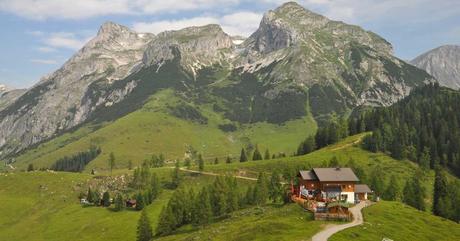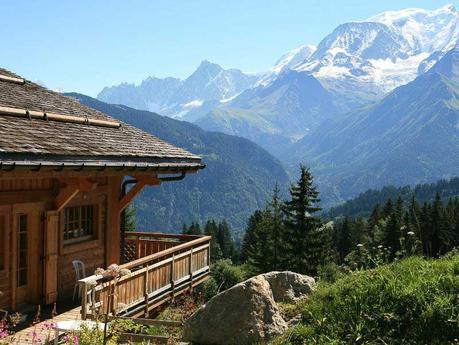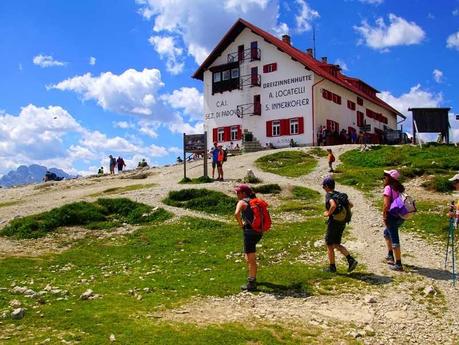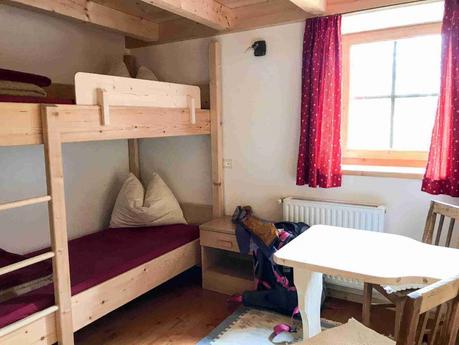This post may include affiliate links, including Amazon Associate links. I may earn money if you click on one at no extra cost to you.
Embarking on a hut to hut hike is one of the best ways to explore and discover the untouched beauty of Europe's fabulous mountain ranges.
I love hut to hut hikes, not just because I love hiking less travelled routes. Mountains huts, especially in Europe offer you a charming experience that is unique even if it isn't luxurious.

From two-day hut hikes in Germany to celebrate New Year's Eve to the multi-day hut to hut hiking in the Dolomites on the Alta Via 1 or the Tour Du Mont Blanc and the Haute Route in the Alps, my experiences have been memorable.
What is Hut to Hut Hiking
Mountain huts are traditional refuges found on mountain treks to give shelter and food to hikers and mountaineers. Surrounded by breathtaking alpine landscapes, they're often secluded and can only be reached on foot.
On a hut-to-hut hike like the Tour du Mont Blanc, you'll hike through mountains and stop each day at a hut where you can sleep, shower and eat. It allows you to explore more terrain each day since you don't have to account for your return time as you do with day hiking - which I tend to do more of.
Related Reading: Southern Via Dinarica in Montenegro, Albania & Kosovo (Private Guided & Small Group)
Most mountain huts are the same, but some of them will offer you better amenities than others. Along the Via Dinarica hiking tour, for instance, you will stay in refuges that offer you hot meals, a shared bathroom and a choice of shared or private dormitories.
On other routes, you may find un-staffed huts that do not offer meals but only a place to sleep and shower. Whichever you choose to stay in, they'll add something special to your hiking adventure.
Related Reading: Hiking for Beginners: What You Need to Know To Start HikingWhat to Expect on a Hut to Hut Hike
Huts are all about simplicity, so don't expect any glamour. They are a far cry from five-star hotels and grand mountain lodges. But, what they lack in luxury, they offer in homely charm that welcomes weary hikers.
Here, you can expect a warm hearty meal, a hot shower, if the hut offers it, and a place to rest your bones before you move on to your next destination. If it's your first time staying at a mountain refuge, here are some of the things you should know to have the best experience.
One of my favourite things about mountain huts is that they're usually nestled into the mountainside and have spectacular views of alpine meadows or towering mountains. On our Haute Route hiking tour, for instance, you will stay at the Cabane Prafleury which is located on a high ridge surrounded by jagged peaks.
Related Reading: 11 Of The Best Mountaineering and Hiking Watches of 2021
Although hut to hut hiking trails in places like the Dolomites and the Tour du Mont Blanc are very popular, you're likely to find more solitude than you would on a popular day hike. It's one of the reasons I enjoy these types of treks more. If you don't enjoy solitude though, you can be assured that once you reach your destined mountain hut, you're likely to meet many hikers.
Many alpine mountain huts don't have wifi, making it the perfect off-grid place to get away from the world. It's a great opportunity to get back in touch with nature and yourself.
If staying in a mountain hut every night of your multi-day trek sounds daunting, you can always choose hiking tours in the Alps and Dolomites that offer a mixture of huts, hotels and guesthouses.
Related Reading: Pre and Post Hike Recovery Plan to Relieve Muscle SorenessThe Advantages of Hut to Hut Hiking
Get to Hard to Reach Places
On hut to hut hikes, you're able to reach places you are unable to reach on a day hike. It's a wonderful way to explore extensive landscapes like the Via Dinarica, a route that makes its way through several countries. On other hut hiking trips such as the Tour du Mont Blanc, you would miss many beautiful landmarks if you didn't overnight in a cozy mountain hut.
Carry Less Gear
Another great perk of staying in a mountain hut is the fact that you don't have to carry extra gear. Items such as cooking utensils, sleeping bags and tents can be left at home. You can get away with the bare essentials like sleeping bag liners. You can use a simple packing list for your hut to hut hike.
Meeting other Hikers
From locals to fellow travellers, you're sure to meet new people at a mountain hut. Other hikers are usually friendly and happy to share hiking stories with you as you enjoy meals and rest.
It's a great way to mingle with like-minded people and even pick up a few tips and tricks about the local mountain trails. During my hut to hut hiking trip in the Dolomites, I was lucky to meet several hikers that offered me invaluable information about the region.
Related Reading: Average Hiking Speed: Why it's Important and How to Calculate it
Avoid Bad Weather
If you choose to stay in a mountain hut, you'll be able to avoid any bad weather that may occur during the night. Unlike staying in a tent, you'll have a solid roof over your head and a lot more comfort. It's one of the reasons I prefer hut to hut hikes to backpacking.
Minimal Environmental Impact
Due to their remote locations, many huts rely on solar panels for energy. Many of them also recycle their rainwater and source their food locally. There is no doubt that staying at a mountain refuge makes a lower environmental impact than staying at a hotel.
Enjoy Hearty Meals
The one thing that I love about hut to hut hikes, is the fact that you don't have to worry about food. Many huts offer you a hot home-cooked meal for breakfast, lunch and supper.
In fact, the mountain huts on the Alta Via 1 route serve some of the best food in all of Europe. You can indulge in local favourites such as pasta, dumplings and filling broths filled with protein to replenish the nutrients you've lost during a day of hiking.
Related Reading: How a Hiking Trip Can Change Your Life And Why You Should Do OneDisadvantages of a Hut to Hut Hike
A Lack of Personal Space
Some mountain huts have private rooms, but these are often few and hard to come by. Even if you do book in advance. Most huts only have shared dormitories that sleep anywhere between 6 and 20 people depending on the location.
And if you're hiking during peak season you can usually expect to have a full dormitory. This means that unless you're travelling in a group, you'll likely be sleeping next to a stranger with no real personal space. If you're really not in luck, that stranger may snore or worse.
Sharing a Bathroom
Most huts offer separate bathrooms for men and women. But, you'll still have to share a small simple bathroom with many strangers. Some huts offer showers, but they may be timed and very short, depending on the amount of water that's been collected from snow or rainfall. Other huts don't have showers at all though.

A Distance Apart
You need to plan your hiking trip based on the location of the mountain huts available. This often determines the distance you'll have to hike for the day. Sometimes those distances can be longer or more difficult than you're prepared for.
You Have to Book in Advance
Usually, you have to book your mountain hut in advance to ensure availability. With the very popular mountain huts, especially during the peak season, you'll have to book quite a while in advance. Booking specific dates means that you lose some flexibility if you're feeling tired or have the energy to keep hiking.

